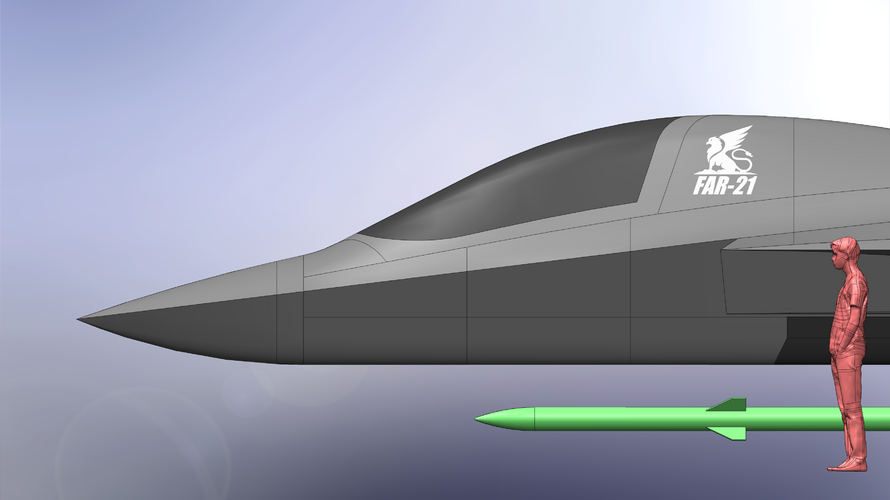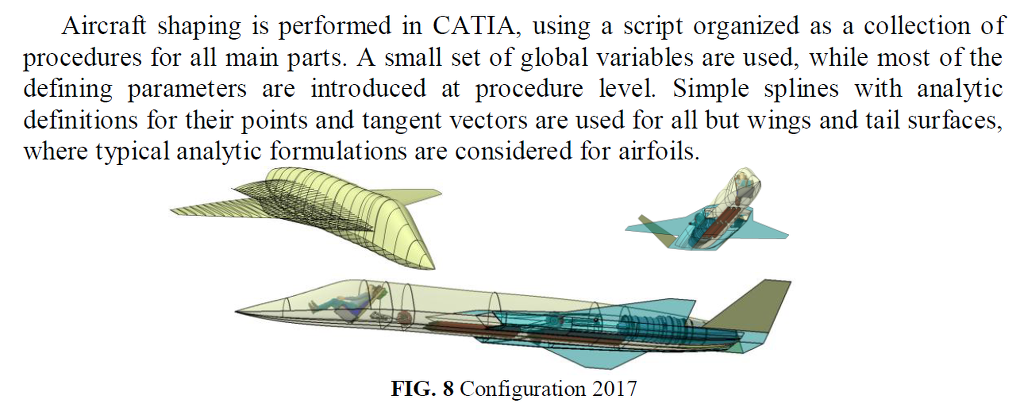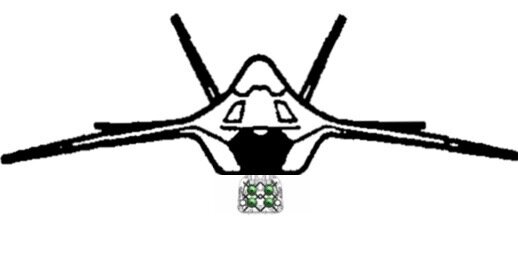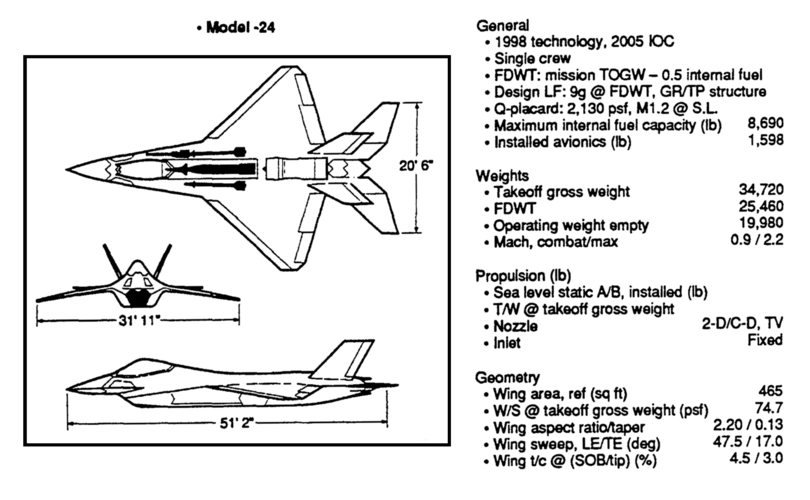You are using an out of date browser. It may not display this or other websites correctly.
You should upgrade or use an alternative browser.
You should upgrade or use an alternative browser.
How small can low observable (stealth) combat aircraft designs get?
- Thread starter helmutkohl
- Start date
Hypersonics Anonymous
ACCESS: Restricted
- Joined
- 3 May 2021
- Messages
- 12
- Reaction score
- 37
Anyone considered submerged weapons or fuel tanks (like those on the strike F-15) that add to an aircraft's stealthiness but can be jettisoned and still make the aircraft stealthy? That way you could at least have a standoff interceptor that becomes more and more like a fighter the more ordnance it drops.

Pure speculation, of course.
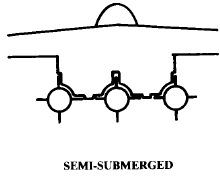
Pure speculation, of course.
TMA1
ACCESS: Top Secret
- Joined
- 6 February 2021
- Messages
- 556
- Reaction score
- 858
I think the new South Korean fighter is using just that kind of A2A setup in its first iteration. Later on the developed internal weapons bay will be used.Anyone considered submerged weapons or fuel tanks (like those on the strike F-15) that add to an aircraft's stealthiness but can be jettisoned and still make the aircraft stealthy? That way you could at least have a standoff interceptor that becomes more and more like a fighter the more ordnance it drops.
View attachment 661280
Pure speculation, of course.
- Joined
- 25 January 2020
- Messages
- 1,279
- Reaction score
- 1,948
It can only be as small as the equipment it needs to carry. It really depends on how big the engine is and whether or not you want a LO platform, or a VLO platform. If you want a LO platform, then weapons can be carried in stealth pods or semi-recessed, but VLO platforms require internal storage. It also depends on mission requirements, as radar and listening equipment take up space too. Endurance is also another question.
Is it possible to make a small stealth platform? Yes, but at a cost. If you want to make a LO platform, then certain corners can be cut, whereas a VLO platform requires complete internal storage, which would increase size.
It also depends on how you are going to operate the aircraft, as certain ways of making aircraft stealthy (such as reducing heat signature), is just as important as making its signature reduced to radar.
It all depends on the requirements really.
Is it possible to make a small stealth platform? Yes, but at a cost. If you want to make a LO platform, then certain corners can be cut, whereas a VLO platform requires complete internal storage, which would increase size.
It also depends on how you are going to operate the aircraft, as certain ways of making aircraft stealthy (such as reducing heat signature), is just as important as making its signature reduced to radar.
It all depends on the requirements really.
- Joined
- 2 August 2006
- Messages
- 3,255
- Reaction score
- 1,527
Anyone considered submerged weapons or fuel tanks (like those on the strike F-15) that add to an aircraft's stealthiness but can be jettisoned and still make the aircraft stealthy? That way you could at least have a standoff interceptor that becomes more and more like a fighter the more ordnance it drops.
View attachment 661280
Pure speculation, of course.
Yes, there are many studies on using this arrangement going back to the 70s if not the 60s. Also, in the 90s, McDonnell Douglas (Now Boeing) looked at doing this with panels around the weapons in the front and the sides to shield their signature return. Once the ordnance was expanded, the panels would be ejected, creating a smooth belly. You can see that Mitsubishi took this tact on their X-2 Technology demonstrator around the tail hook. As with everything in aircraft design, it's all a tradeoff. So far, for U.S. mission specs, internal weapons bays have been the best solution.
- Joined
- 24 November 2008
- Messages
- 1,549
- Reaction score
- 2,606
- Joined
- 29 November 2010
- Messages
- 1,773
- Reaction score
- 3,474
^ awesome.
the canopy reminds me of the X-2 mock up

the canopy reminds me of the X-2 mock up
Considering loyal wingman is small and likely carries 2 -4 cuda sized missiles I don't think a f16 sized stealth fighter is impossible. It just isn't going to be useful because of fuel. Want to go smaller like an f20, dump the cockpit and you probably are a loyal wingman. A fighter is only as useful as its weapons and ability to reach a target and of course return to flight another day.
Dumb question perhaps.... But what if we make the missiles stealthy? The controlfins can be made from radar-transparent materials? Strong parts ( to control the fins) can be shape optimized to deflect radar waves away from the source.. We have all seen stealth cruise-missiles and such, how small can those become?
A small aircraft could then externally ( or semi submerged into the fuselage) carry more or larger weapons. Just my 2 cents.
I should make my sketches into 3d... someday ...
A small aircraft could then externally ( or semi submerged into the fuselage) carry more or larger weapons. Just my 2 cents.
I should make my sketches into 3d... someday ...
- Joined
- 25 January 2020
- Messages
- 1,279
- Reaction score
- 1,948
I guess the only problem at that point is cost of missile development, and it may be unpopular amongst commanders, as they would see the missiles as being expendable. I do see your point however, and it certainly has crossed my mind before.
- Joined
- 11 February 2010
- Messages
- 1,648
- Reaction score
- 2,695
Dumb question perhaps.... But what if we make the missiles stealthy? The controlfins can be made from radar-transparent materials? Strong parts ( to control the fins) can be shape optimized to deflect radar waves away from the source.. We have all seen stealth cruise-missiles and such, how small can those become?
A small aircraft could then externally ( or semi submerged into the fuselage) carry more or larger weapons. Just my 2 cents.
I should make my sketches into 3d... someday ...
The shape of the body. put the strongest reflection away from likelyhood of threat, generous use of radar absorbers. Radio transparent material can maybe help BUT. if that material requires any reinforcements the reinforced structure will be visible instead as the radiowave penetrates the radiotransparent part. Two kinds of reflections of interest are Specular and Surface wave/creepig wave.
Specular are the strongest and their lobes are function of frequency and area of the illuminated place. Ideally you would want this lobe to be as small as possible, they are stronger BUT less likely to be "re-captured" by enemy radar, Thus why you angle the surface of concern away, the enemy will then see much weaker specular sidelobes. and no.. angling the surface away wont make the reflection disappear (or could be zero) as some might suggest... We live in real world where law of diffraction exist... you have strong "mainlobe" reflection... you will always have weaker sidelobe accompanying it.
Surface and creeping wave is the phenomenon where the EM wave behave like fluid and "ice skating" on the surface of the body. This occurs when the wavelength is about the same or slightly bigger than the body/missile. You would see MIE Scattering where RCS is fluctuating drastically, the other phenomenon resulted from above is diffraction where the EM wave hits any discontinuities be it gaps or material differences within the body, the wave then scatter around in multiple direction.
Surface and creeping wave is supressed using materials which weakens them but.. practicality remains concern as low frequency absorbers easily got so thick. Only big platform can afford that.
Thus why the edge of the surfaces (wings, fins) of missiles or aircraft are subject to edge treatment. Should the missile use electro-optical means of guidance (TV,IR) The window material would have gold coating to reflect the radar away, further control is then achieved by angling the surface away from the expected threat angle. Or just accept circular window with relatively broad lobe but still weaker than RCS contribution from interaction between the EM wave and the seeker structures.
The following is an example that i did. This is a lifting body stealthy cruise missile. As seen it is capable of extremely low RCS in expected frontal section. it reached a median 0.002 sqm Without RAM treatment. it is a pure PEC body.

You can see the behavior of the Reflection in different frequency, notice that the strongest reflection comes from wing area from X to L . It may be very strong but The lobes are relatively small, it will be hard to pick the strongest part, as can be seen from the contourplot
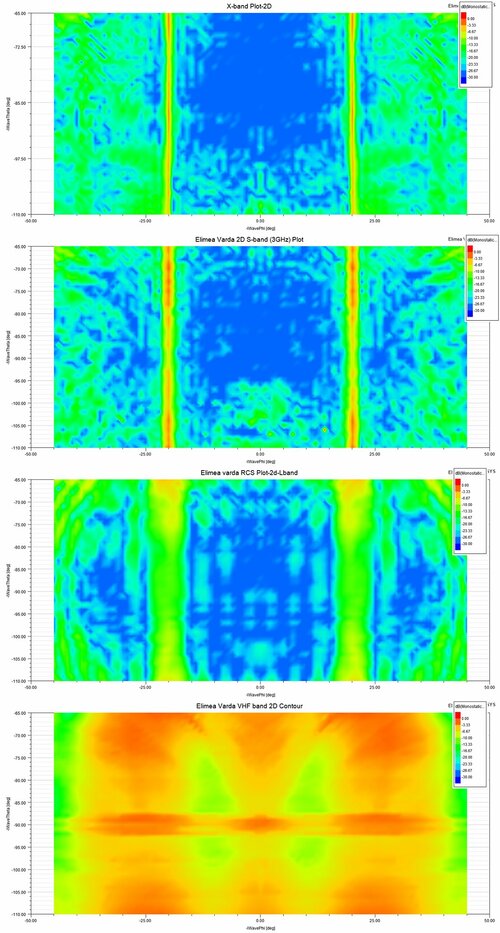
This is what you want to achieve. VHF however is another story where the missile shape lost its ability to control RCS and become blobs. Compare it to conventional cruise missile here at X-band
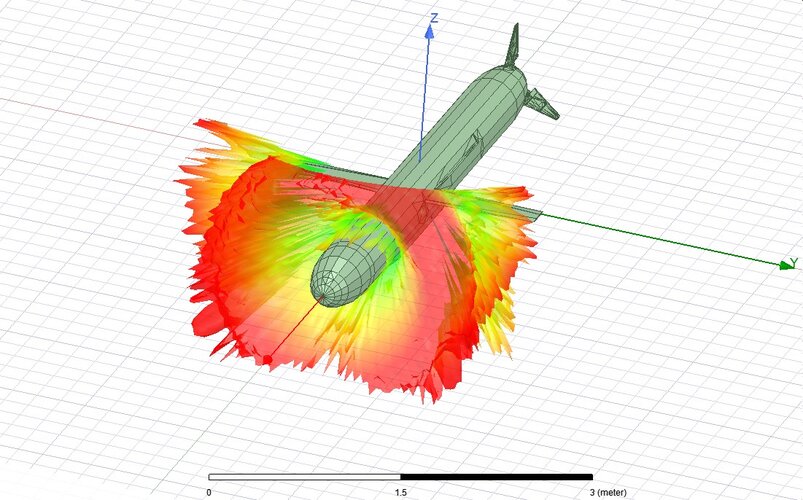
The contour plot
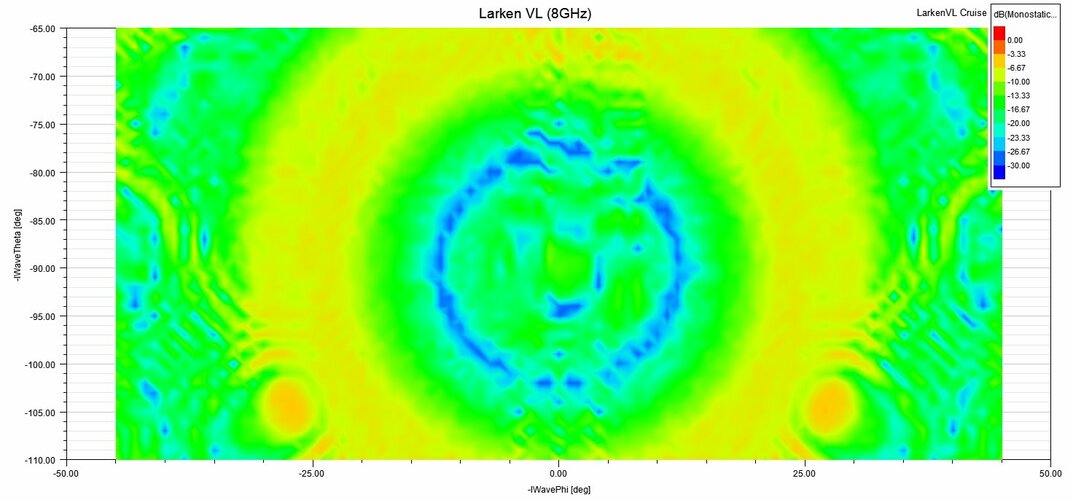
One can see the axisymmetric airframe gives "halo" reflection. still relatively small but when one see the numbers.
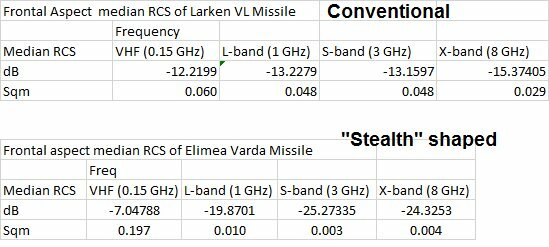
Notice the stealthy cruise missile give more dramatic reduction at higher frequency. While the conventional one the RCS is higher but not as fluctuative. You may also notice that the conventional have bit of lower RCS in VHF band. This is the result of the MIE scattering. You may see lower RCS value in a frequency but not in the other and this conventional one were happen to be in "favorable" frequency.
Aeroengineer1
Engineering, not just a job, but a lifestyle :)
- Joined
- 27 January 2008
- Messages
- 122
- Reaction score
- 102
I am curious as to what tool you use to do your Rf evaluations? It looks really nice.Dumb question perhaps.... But what if we make the missiles stealthy? The controlfins can be made from radar-transparent materials? Strong parts ( to control the fins) can be shape optimized to deflect radar waves away from the source.. We have all seen stealth cruise-missiles and such, how small can those become?
A small aircraft could then externally ( or semi submerged into the fuselage) carry more or larger weapons. Just my 2 cents.
I should make my sketches into 3d... someday ...
The shape of the body. put the strongest reflection away from likelyhood of threat, generous use of radar absorbers. Radio transparent material can maybe help BUT. if that material requires any reinforcements the reinforced structure will be visible instead as the radiowave penetrates the radiotransparent part. Two kinds of reflections of interest are Specular and Surface wave/creepig wave.
Specular are the strongest and their lobes are function of frequency and area of the illuminated place. Ideally you would want this lobe to be as small as possible, they are stronger BUT less likely to be "re-captured" by enemy radar, Thus why you angle the surface of concern away, the enemy will then see much weaker specular sidelobes. and no.. angling the surface away wont make the reflection disappear (or could be zero) as some might suggest... We live in real world where law of diffraction exist... you have strong "mainlobe" reflection... you will always have weaker sidelobe accompanying it.
Surface and creeping wave is the phenomenon where the EM wave behave like fluid and "ice skating" on the surface of the body. This occurs when the wavelength is about the same or slightly bigger than the body/missile. You would see MIE Scattering where RCS is fluctuating drastically, the other phenomenon resulted from above is diffraction where the EM wave hits any discontinuities be it gaps or material differences within the body, the wave then scatter around in multiple direction.
Surface and creeping wave is supressed using materials which weakens them but.. practicality remains concern as low frequency absorbers easily got so thick. Only big platform can afford that.
Thus why the edge of the surfaces (wings, fins) of missiles or aircraft are subject to edge treatment. Should the missile use electro-optical means of guidance (TV,IR) The window material would have gold coating to reflect the radar away, further control is then achieved by angling the surface away from the expected threat angle. Or just accept circular window with relatively broad lobe but still weaker than RCS contribution from interaction between the EM wave and the seeker structures.
The following is an example that i did. This is a lifting body stealthy cruise missile. As seen it is capable of extremely low RCS in expected frontal section. it reached a median 0.002 sqm Without RAM treatment. it is a pure PEC body.
View attachment 674717
You can see the behavior of the Reflection in different frequency, notice that the strongest reflection comes from wing area from X to L . It may be very strong but The lobes are relatively small, it will be hard to pick the strongest part, as can be seen from the contourplot
View attachment 674714
This is what you want to achieve. VHF however is another story where the missile shape lost its ability to control RCS and become blobs. Compare it to conventional cruise missile here at X-band
View attachment 674715
The contour plot
View attachment 674718
One can see the axisymmetric airframe gives "halo" reflection. still relatively small but when one see the numbers.
View attachment 674716
Notice the stealthy cruise missile give more dramatic reduction at higher frequency. While the conventional one the RCS is higher but not as fluctuative. You may also notice that the conventional have bit of lower RCS in VHF band. This is the result of the MIE scattering. You may see lower RCS value in a frequency but not in the other and this conventional one were happen to be in "favorable" frequency.
- Joined
- 11 February 2010
- Messages
- 1,648
- Reaction score
- 2,695
I am curious as to what tool you use to do your Rf evaluations? It looks really nice.
Thank you.
I am using ANSYS-HFSS. It's basically a gamechanger compared to POFACETS or MGL_RCS i previously used in the past.
_Del_
I really should change my personal text... Or not.
- Joined
- 4 January 2012
- Messages
- 1,315
- Reaction score
- 1,809
The problem would then be that the missile RCS as an individual body does not mean that the interactions between the body of the missile and the body of the carrying aircraft behave the same way. We can't simply add the RCS figure of the LO missile to the figure of LO airframe and compute a total RCS. It is much uglier in practice.Dumb question perhaps.... But what if we make the missiles stealthy? The controlfins can be made from radar-transparent materials? Strong parts ( to control the fins) can be shape optimized to deflect radar waves away from the source.. We have all seen stealth cruise-missiles and such, how small can those become?
A small aircraft could then externally ( or semi submerged into the fuselage) carry more or larger weapons. Just my 2 cents.
I should make my sketches into 3d... someday ...
What if you stop trying to be extremely low drag and concentrate on efficiency at high subsonic speeds. You could optimize for Mach .875 and concentrate on MMI and internal payload. Something more akin to an A-6 tadpole shape or the piggy shape of the Blackburn Buccaneer, only on a much smaller scale. You probably end up with a blended wing into the body, similar to X-45B or X-47.
Thanks for explaining it to me guys.The problem would then be that the missile RCS as an individual body does not mean that the interactions between the body of the missile and the body of the carrying aircraft behave the same way. We can't simply add the RCS figure of the LO missile to the figure of LO airframe and compute a total RCS. It is much uglier in practice.Dumb question perhaps.... But what if we make the missiles stealthy? The controlfins can be made from radar-transparent materials? Strong parts ( to control the fins) can be shape optimized to deflect radar waves away from the source.. We have all seen stealth cruise-missiles and such, how small can those become?
A small aircraft could then externally ( or semi submerged into the fuselage) carry more or larger weapons. Just my 2 cents.
I should make my sketches into 3d... someday ...
I had another thought, you read often that stealth-planes are mission optimised from the start, like the B2 started out as low altitude design and then pretty late switched to high altitude because of the danger of some new Russian missile. Also shaping can hide stuff from angles. So why isn't there a design with missiles on top of the plane? In the shadow of the cockpit for example? The missiles would be invisible from beneath and from the frontal view. If it flies high enough nothing would see it top-view with some nasty radar reflections. Also flying high enough means that if it has some big radar returns, it would be late to very late to send a SAM after it.
Just a tought
- Joined
- 27 December 2005
- Messages
- 17,744
- Reaction score
- 26,337
It has been considered several times, but its a lot harder to achieve separation safely as gravity will tend to pull the missiles down.
If an internal bay is deep/wide enough to house enough fuel, then a better solution would be to develop a LO drop tank and use the weapons bay as is. F-22 has already demonstrated a drop-pylon which separates from the aircraft when the drop tank is jettisoned so that's another handy solution. All we need then is a self-sealing connection to the pylons.Could we develop stealth ordnance pods for A2G munitions and modify internal bays to accept drop tanks to improve range when in the strike role
Last edited:
Scott Kenny
ACCESS: USAP
- Joined
- 15 May 2023
- Messages
- 11,553
- Reaction score
- 14,157
The bigger question would be "Why it has to be in Gripen weight-size class ?"
I'm just going to point out that the most recent Gripen sales have run about $88mil per plane, when the F-35 is $82mil and dropping.$$$$$
It's all the electronics inside that cost, if you want F-35 capabilities you are going to pay F-35 prices.
=====
As to size of the smallest practical stealth fighter, I think we're probably looking at the CALF designs like the X-32. ~6x AAMs in air patrol mode all stealthy, 2x AAM and 2x 2000lb bombs for stealthy interdiction.
Scott Kenny
ACCESS: USAP
- Joined
- 15 May 2023
- Messages
- 11,553
- Reaction score
- 14,157
Not if you want that internal bay to have any decent capacity. 1x 2000lb bomb and 2x AMRAAMs, or 4-6x AMRAAMs is probably the minimum bay volume to deal with. Not that I expect many missions with that 2000lb bomb, but it's not a good idea to ignore a very likely strike mission profile.however like some others said, this is a question if stealth fighters can even be scaled down to a Gripen/FC-1/Tejas/F-20 weight category, or is the F-35 and friends, the smallest one can go as a stealth fighter due to its unique requirements of needing an internal bay, in addition to gas, sensors, other avionics, etc
That's what I'm starting to think. The internal bay requirement really dives up the airframe volume. My mental image for the "right" sized bay is one big enough for a 2000lb BLU-109 JDAM-ER and a pair of AMRAAMs in heavy strike configuration, or 4-6x AMRAAMs in an air defense configuration.Would not a Gripen-sized sixth-gen fighter be a loyal wingman?
What is the "smallest" a 5th or higher gen manned LO aircraft can be?
...
With MiG throwng out all kinds of models, it made me want to talk about what the minimum size manned LO aircraft could be?
- Bays? could a light weight LO aircraft just have one bay, like many of those stealthy UCAVs?
- Range? bays take up space for what could be used for fuel. If its a small design, it likely wont have much range.
- Does one need LO for a short range fighter? usually LO is associated with stealthy strike, which requires range. a short range fighter tends to be more defensive.. is LO necessary?
- UCAVs, would UCAVs be a better fit for the field of small LO fighters?
- Yes, one bay is totally possible. In fact, since this plane won't have to deal with a STOVL requirement like JSF did, one bay is more likely than multiple bays.
- As for range, bays also increase frontal area, which can increase internal volume for fuel. The F-35 has pretty good range because of that.
- LO, at least in terms of X-band radar and some IR awareness, is a great help to that aircraft's survival chances on the battlefield. So I think that limited LO is a requirement. Broadband stealth like the B-2 or B-21 is not necessarily required. Desired, almost certainly, but not if broadband stealth will greatly drive up the cost of the aircraft.
- It is still advantageous to have a pilot right there, to see what the intruding aircraft is doing (assuming that the small LO fighter is mostly used for air policing and interception than strike)
Sure, Boeing has some designed for their Super Hornet, and @VTOLicious based his design around one, using that pod as the size of his bay. I think it's a little too small for a fighter, however, as that pod is too small to hold both a 2000lb bomb and a pair of AAMs of any type. Sure, it'll actually hold 2x AMRAAMs and 6x SDBs, but not a 2000lb bomb and a pair of AAMs.Could we develop stealth ordnance pods for A2G munitions and modify internal bays to accept drop tanks to improve range when in the strike role
Since the underlying assumption is that this small LO fighter is for second world economies that cannot afford two separate aircraft types (both pure fighter and attack), it must be able to carry bombs. Even if 90% of the Air Force missions involve it carrying pure air-to-air.
Yes but why carry 2,000lb bombs at all? Anything needing that kind of destructive power is best handled by a cruise missile or relatively inexpensive JSOW-ER style powered glide bomb (which can be carried externally and launched from stand-off ranges). Or these days increasingly by a long-range, ground-launched attack drone.Since the underlying assumption is that this small LO fighter is for second world economies that cannot afford two separate aircraft types (both pure fighter and attack), it must be able to carry bombs
This leaves the following attack missions for stealth fighters: air & ground interdiction, SEAD/DEAD etc… missions with large numbers of aimpoints, that can only be done by penetrating into heavily defended airspace. For this 6x SDBs would be perfectly well suited.
Scott Kenny
ACCESS: USAP
- Joined
- 15 May 2023
- Messages
- 11,553
- Reaction score
- 14,157
It's about the volume. There may be a mission that for whatever reason needs a manned aircraft to lug a BLU-109 bunker buster someplace. It's probably very low probability, I agree. 6x SDBs is a much more likely strike mission. However, most cluster bombs (or cluster bomb replacements, like the CBU-107 tungsten dart package) are pretty bulky, being about the size of a 1000lb bomb when the CBU is only 500lbs in weight, or being the size of a 2000lb bomb when 1000lbs in weight. The SUU-66/B package used for the CBU-97, CBU-105 WCMD, and CBU-107 PAW is 92"/234cm long and 15.6"/40cm in diameter.Yes but why carry 2,000lb bombs at all? Anything needing that kind of destructive power is best handled by a cruise missile or relatively inexpensive JSOW-ER style powered glide bomb (which can be carried externally and launched from stand-off ranges). Or these days increasingly by a long-range, ground-launched attack drone.
This leaves the following attack missions for stealth fighters: air & ground interdiction, SEAD/DEAD etc… missions with large numbers of aimpoints, that can only be done by penetrating into heavily defended airspace. For this 6x SDBs would be perfectly well suited.
(Side note: a B61 nuke is about the size of a 2000lb bomb, so the "stealthy Gripen" being able to carry a 2000lb bomb internally means it's possible to be nuclear capable. Probably not a selling point except to NATO nations.)
That said, the Boeing EWP stealthy ordnance pod is also only able to fit a single 1000lb bomb, with no space for AAMs. So if your ordnance needs to be bigger than an SDB or 500lber, say goodbye to your AAMs. @VTOLicious FAR-21 design gets around this by having a single IRIS-T in the area-ruling hump over the engine. Not sure how I feel about that, but it does give one defensive missile.
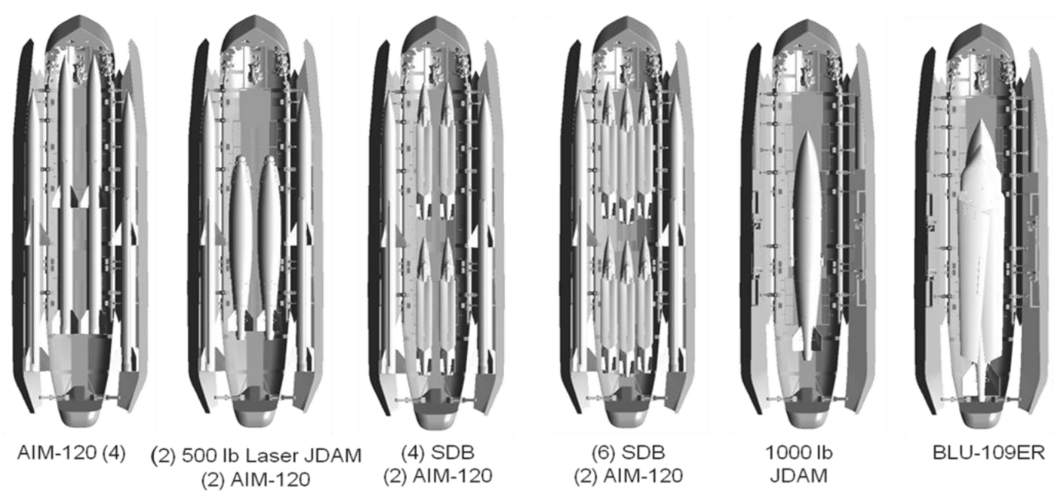
I would want the bay to be enough wider than the Boeing EWP to allow for carrying a pair of AMRAAMs in addition to that one large bomb. As a side benefit, I believe it would make enough space to add another pair of SDBs, allowing 8x in total, and maybe another AMRAAM-length missile. But if we get CUDAs or other "Halfraams", 4x AMRAAMs and a pair of Half-RAAMs in an air to air load sounds very nice. (The other option is making the bay deeper, but I think from an access/loading perspective a wider bay is better than deeper)
I think basic scaling puts a 2x 2000lb sized bay right at the edge of possibility for a fighter pushed by a single F414-class engine, and I'm not entirely sure which side of that edge it really sits on.
What I am after is space for a single large boom and a pair of BVRAAMs, with the expectation that the standard mission for the aircraft being 4x or whatever fits BVRAAMs. The standard ground attack mission for the aircraft is 2x BVRAAMs and 2x 500lb LJDAMs or 2x BVRAAMs and 6x-8x SDBs. A rare ground attack mission would be a CBU-107 strike.
BLACK_MAMBA
ACCESS: Secret
- Joined
- 17 July 2019
- Messages
- 382
- Reaction score
- 877
Scott Kenny, I believe you are starting to point out exactly what many others before you on this forum has also reasoned - that a stealth fighter with an internal weapons bay more than likely does have an minimum size - which is l bigger than Gripen. This thread however specifically aimed at meeting the Gripen size and weight limits.
Scott Kenny
ACCESS: USAP
- Joined
- 15 May 2023
- Messages
- 11,553
- Reaction score
- 14,157
I think we could still stay within roughly Gripen size (but not weight) by widening the bay 7-8" and keeping the BVRAAM mounts the same distance from the bottom corners of the bay doors as the existing pod.Scott Kenny, I believe you are starting to point out exactly what many others before you on this forum has also reasoned - that a stealth fighter with an internal weapons bay more than likely does have an minimum size - which is l bigger than Gripen. This thread however specifically aimed at meeting the Gripen size and weight limits.
It's beyond my available tool set to figure out what that would do to the airframe drag, unfortunately.
- Joined
- 11 February 2010
- Messages
- 1,648
- Reaction score
- 2,695
Any limitation from such weight class tho is to be accepted tbh. The only hope is that the aircraft would be ordered en-masse which can quickly cut costs.
If one wish more payload, then the weapon must get smaller to make maximum use of volume inside weapon bays.
If one wish more payload, then the weapon must get smaller to make maximum use of volume inside weapon bays.
kqcke for you
PUMA PUMA PUMA
- Joined
- 3 November 2022
- Messages
- 1,280
- Reaction score
- 1,688
Well one can allways add loyal wingman or other drones to carry the big bombs or one needs to make a special pod like the one from Boeing which can hold 2000lb bombs.
Perhaps not quite Gripen sized, but here’s what I get using Boeing’s Model 24F… looks pretty good IMHO.I think we could still stay within roughly Gripen size (but not weight)
Empty weight: 9t
Fuel: 4t / 5.5t with/without internal bomb bay
Weapons:
- 2x AAMs internally
- 1x JSOW/NSM class weapon or 2,000lb GBU internally
- Or 4 AAMs or 2x AAMs + 6x SDB in EWP (Enclosed Weapons Pod)
This compares favorably to the F-16:
Empty weight: 9t (9.5t with CFT)
Fuel: 3.2t (4.6t with CFT)
I personally prefer the Enclosed Weapons Pod to the bomb bay option.
Attachments
Last edited:
Scott Kenny
ACCESS: USAP
- Joined
- 15 May 2023
- Messages
- 11,553
- Reaction score
- 14,157
certain mission types require a large weapon. Nuclear being the primary one, but also conventional bunker busters.Any limitation from such weight class tho is to be accepted tbh. The only hope is that the aircraft would be ordered en-masse which can quickly cut costs.
If one wish more payload, then the weapon must get smaller to make maximum use of volume inside weapon bays.
Scott Kenny
ACCESS: USAP
- Joined
- 15 May 2023
- Messages
- 11,553
- Reaction score
- 14,157
Kinda makes me wonder if it would be possible to make an F-35 variant with a centerline weapons bay where the liftfan/fuel tank is. I mean, there's structure there to support what's basically an open volume already, the question is "what are the usable dimensions of that space and could you stuff a couple more AMRAAMs or even a 2000lb bomb or two in there?"About the F-35 and why it may not be a 100% applicable example when estimating the chances of creating a stealth light fighter, I think the STOVL requirement is the key aspect to consider: it forced the engine forward, then the bays had to be moved at the sides of the engine. (BTW, the lift fan is also incompatible with ventral, central bays).
LMFS
ACCESS: Top Secret
- Joined
- 19 March 2019
- Messages
- 533
- Reaction score
- 880
On the one hand, the bay would be too short for A2G heavy ordnance, on the other, the "Y" shaped inlet from the side intakes stays right in the middle of the space. That is why A and C variants have more internal space, but not that much. BTW the fuel tank is dorsal while the bays are ventral. IMHO you would need to move the engine rearwards by a relevant amount i.e., design a different plane..Kinda makes me wonder if it would be possible to make an F-35 variant with a centerline weapons bay where the liftfan/fuel tank is. I mean, there's structure there to support what's basically an open volume already, the question is "what are the usable dimensions of that space and could you stuff a couple more AMRAAMs or even a 2000lb bomb or two in there?"
Scott Kenny
ACCESS: USAP
- Joined
- 15 May 2023
- Messages
- 11,553
- Reaction score
- 14,157
Bugger. I was hoping that the volume there was big enough for another 2000lb bomb or two.On the one hand, the bay would be too short for A2G heavy ordnance, on the other, the "Y" shaped inlet from the side intakes stays right in the middle of the space. That is why A and C variants have more internal space, but not that much. BTW the fuel tank is dorsal while the bays are ventral. IMHO you would need to move the engine rearwards by a relevant amount i.e., design a different plane..
We think of stealth fighters with small, internal non-stealth weapons.
I might flip that.
A stealthy version of the Hustler's belly fuel weapon pod with the plane just being a parasite that keeps jet, avionics, and a small internal fuel bay that flies out of harms way leaving the weapon pod to descend
I might flip that.
A stealthy version of the Hustler's belly fuel weapon pod with the plane just being a parasite that keeps jet, avionics, and a small internal fuel bay that flies out of harms way leaving the weapon pod to descend
Prophet141
ACCESS: Confidential
- Joined
- 25 April 2022
- Messages
- 142
- Reaction score
- 121
It has been considered several times, but its a lot harder to achieve separation safely as gravity will tend to pull the missiles down.
This might be stupid for fighter launched Air to Air weaponry, but what about an A-5 Vigilante style rearward tube magazine? You could either have one such magazine between two engines, or two on either side of a single engine.
The biggest issue that I can identify immediately is order of drops. If you have a bomb cued up before your missile, will you have to drop that before you can drop the missile? And vice versa.
However, that would partially be mitigated by the fact that most conventional ordnance isn't the size of a nuclear bomb, as the Vigilante has to cope with, so your different weapons could be on different rails that let them out in whatever order you need. Of course, that starts adding width.
All of this is totally invalid if there was some particular, dangerous reason the Vigilante's system was never pursued again in following designs.
How important would it be for a proposed small stealth fighter to carry self defense AA missiles all the time? I'd imagine you could task a few fighters of the strike group with AA roles, a few fighters with 500lb JDAM and 2x AMRAAM, and a few with one 1000lb bomb. A small half-ram might be able to fit in with the 1000lb bomb as well.
Or could you replace the AMRAAM on the door with SDB? If so I wonder if 2 SDB's (one on each door) would fit with the 1000lb bomb for a A2G role. Or 2 500lb JDAM with 4x SDB.
Or could you replace the AMRAAM on the door with SDB? If so I wonder if 2 SDB's (one on each door) would fit with the 1000lb bomb for a A2G role. Or 2 500lb JDAM with 4x SDB.
Scott Kenny
ACCESS: USAP
- Joined
- 15 May 2023
- Messages
- 11,553
- Reaction score
- 14,157
There were accuracy issues with the Vigilante system. Bombs tended to get carried along in the wake and bounce around.This might be stupid for fighter launched Air to Air weaponry, but what about an A-5 Vigilante style rearward tube magazine? You could either have one such magazine between two engines, or two on either side of a single engine.
The biggest issue that I can identify immediately is order of drops. If you have a bomb cued up before your missile, will you have to drop that before you can drop the missile? And vice versa.
However, that would partially be mitigated by the fact that most conventional ordnance isn't the size of a nuclear bomb, as the Vigilante has to cope with, so your different weapons could be on different rails that let them out in whatever order you need. Of course, that starts adding width.
All of this is totally invalid if there was some particular, dangerous reason the Vigilante's system was never pursued again in following designs.
red admiral
ACCESS: Top Secret
- Joined
- 16 September 2006
- Messages
- 1,805
- Reaction score
- 2,374
The tubes extending to the back of the aircraft take up a lot of volume unless you design new weapons with folding fins etc. With multiple tubes then you'll also end up with a lot of rear fuselage volume which is bad for drag.
I think the volume is the key thing; for a small supersonic aircraft with internal weapon bays then you really need to minimise the numbers of weapons carried as this drives max cross sectional area, then length, mass etc.
I think the volume is the key thing; for a small supersonic aircraft with internal weapon bays then you really need to minimise the numbers of weapons carried as this drives max cross sectional area, then length, mass etc.
Scott Kenny
ACCESS: USAP
- Joined
- 15 May 2023
- Messages
- 11,553
- Reaction score
- 14,157
Sure, but I suspect that the minimum acceptable internal weapons load is still going to be 2x 2000lb bombs and 2x BVRAAMs.I think the volume is the key thing; for a small supersonic aircraft with internal weapon bays then you really need to minimise the numbers of weapons carried as this drives max cross sectional area, then length, mass etc.
Similar threads
-
-
A Low(er) Observable Eurofighter?
- Started by Siberia
- Replies: 2
-
Design Challenge: Lightweight Multirole Fighter (LMF)
- Started by VTOLicious
- Replies: 506
-
-

